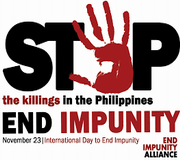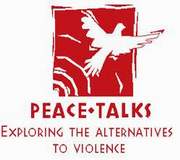From: JOSE MARIA SISON WEBSITE
NEGOTIATIONS FOR A JUST AND LASTING PEACE: BACKGROUND, CURRENT STATUS AND PROSPECTS
By Prof. Jose Maria Sison
Founding Chairman of the Communist Party of the Philippines
Chief Political Consultant, National Democratic Front of the Philippines
Dear Compatriots and Friends,
Greetings of peace and solidarity! I thank the Political Science Society and its President Terso Araza, Jr. for inviting me to speak on the peace negotiations between the Government of the Philippines (GPH) and the National Democratic Front of the Philippines (NDFP).
I shall give you a basically informative presentation on the background, current status and prospects of said negotiations. I shall make my speech short to allow more time for the open forum and the other speakers.
I. Background
A. The Armed Conflict.
A nationwide civil war exists between the US-dominated reactionary big comprador-landlord Government of the Philippines (GPH) and the people’s democratic government of workers and peasants and all the revolutionary forces and people represented by the National Democratic Front of the Philippines (NDFP. It has been going on since 1969.
Since 1992 upon the forging of The Hague Joint Declaration, the two conflicting sides, the GPH and NDFP, have agreed to engage in peace negotiations to address the roots of the armed conflict and to arrive at agreements to lay the basis for a just and lasting peace. Prior to the aforesaid declaration, there was the 60-day ceasefire agreement on November 27 1986 to create the atmosphere for negotiating and agreeing on the agenda for peace negotiations.
But the ceasefire agreement broke down as a result of the Mendiola massacre of peasants and their supporters on January 22, 1987. Taking advantage of the intelligence gathered during the period of ceasefire negotiations and agreement, the Aquino regime launched a brutal military and police campaign against the revolutionary movement. In her own words, Cory Aquino unsheathed the “sword of war” and launched the US-designed Oplan Lambat Bitag.
In 1989 when the regime was besieged by worsening political and economic crisis, especially by a coup threats from the Reform the Armed Forces Movement, Mrs. Aquino sent Rep. Jose V. Yap to the Netherlands to offer peace negotiations to the NDFP. The NDFP accepted the offer, with the proviso expressed in an aide memoir to Aquino that the negotiations must be held in a foreign neutral venue in order to avoid the risks and threats of holding the negotiations in the Philippines.
The exploratory talks that Rep. Yap had with the NDFP were moving towards formal talks in The Netherlands. But the military mutiny headed by Col. Noble in northern Mindanao in December, 1990 had the effect of dissuading the Aquino regime from pursuing the peace negotiations.
B. Agreements Made During Ramos Regime
When Fidel V, Ramos became president in 1992, he sent to The Hague a delegation headed by Rep. Jose V. Yap to forge the framework agreement for the entire peace negotiations, The Hague Joint Declaration of September 1, 1992. The agreement was negotiated at a venue provided by the Netherlands Institute of International Relations at ‘Clingendael’.
The declaration sets forth the aim of the peace negotiation, which is to address the roots of the armed conflict through agreements that would lay the basis of a just and lasting peace. It states the mutually acceptable principles of national sovereignty, democracy and social justice as guide. It sets the substantive agenda and method of negotiations and agreement.
Soon after The Hague Joint Declaration on October 28, 1992, President Ramos released hundreds of political prisoners from both the revolutionary movement the military mutineers through general amnesty. However, the formation of the National Unification Commission (NUC) that tried in vain to carry out so-called localized peace talks interfered with the implementation of The Hague Joint Declaration for nearly two years.
After the dissolution of the NUC and the formation of the GRP Negotiating Panel headed by Ambassador Howard Q. Dee in 1994 , major agreements were forged by the negotiating parties in quick succession, such as the following: The Breukelen Joint Statement on June 14, 1994, the Joint Agreement on Safety and Immunity Guarantees (JASIG) on February 24, 1995 and the Agreement on the Ground Rules of the Formal Meetings on February 26, 1995.
The Joint Agreement on the Formation, Sequence and Operationalization of the Reciprocal Working Committee and the Additional implementing Rules Pertaining to the Documents of Identification under JASIG were solemnly signed on June 26, 1995 at the formal opening of the peace negotiations in Brussels upon the facilitation of the Belgian government.
The Negotiating Panels of the GRP and the NDFP succeeded in forging the Comprehensive Agreement on Respect for Human Rights and International Humanitarian Law (CARHRIHL) on March 16, 1998. This fulfills the first of the four items in the substantive agenda of the peace negotiations.
Other agreements signed on the same day were: the Additional Implementing Rules of JASIG Pertaining to the Security of Personnel and Consultations in Furtherance of the Peace Negotiations and the Joint Agreement I Support of Socioeconomic Projects of Private Development Organizations and Institutes.
C. Paralysis of the Peace Process in Post Ramos Regimes
The GRP-NDFP peace negotiations became paralyzed most of the time during the regimes of Estrada, Arroyo and Aquino despite auspicious starts. In common these post Ramos regimes were obsessed with seeking the capitulation and pacification of the revolutionary forces and people, instead of addressing the roots of the armed conflict and arriving at agreements to lay the basis for a just and lasting peace.
President Estrada made an auspicious start by signing and approving the CARHRIHL on August 11, 1998 (in accordance with Memorandum Order No. 9 dated August 7, 1998). But he resented the capture of General Obillo and Captain Montealto by the New People’s Army and the criticisms and opposition of the NDFP to his approval of the Visiting Forces Agreement with the US. Thus, he ordered the termination of the JASIG and the entire peace negotiations on May 31, 1999.
President Arroyo also made an auspicious start by agreeing with the NDFP in the first half of 2001 to foil the assassination plots by the previous regime against the NDFP chief political consultant, the holding of the International Solidarity Conference in support of the Philippine peace process, having the Norwegian Royal Government as third party facilitator, resuming the formal talks and reaffirming all previous agreements, approving the Operating Guidelines for the Joint Monitoring Committee (JMC)under CARHRIHL and creating the offices of the Secretariats of the GRP and NDFP of the JMC.
But in June 2001 the negotiations broke down when the GRP took offense at the killing of the notorious human rights violator Rodolfo Aguinaldo who resisted the attempt of the NPA to arrest him. The GRP negotiating panel walked out of the peace negotiations despite the obvious absence of a ceasefire agreement with the NDFP. The GRP-NDFP peace negotiations were further paralyzed by the Arroyo regime’s unlawful breach of the JASIG by “suspending” it rather than categorically terminating it.
The worst offenses committed by the Arroyo regime against the peace process were the adoption of the US policy of terror, the request to the US government for the designation of the CPP, NPA and the NDFP chief political consultant as “terrorists” and the gross and systematic human rights violations under Oplan Bantay Laya, which included the abduction, illegal detention, torture and extrajudicial killings of NDFP consultants in the peace process.
President Aquino hesitated to resume the peace negotiations with the NDFP. He believed the advice of the US, the military and the Akbayan that the NPA was already a spent force and became more obsessed with seeking to destroy or rendering the NPA inconsequential through the US-designed military Oplan Bayanihan, the cash doleouts under PAMANA of the OPAPP and deployment of more military forces against the NPA by prolonging the ceasefire with the MILF. Oplan Bayanihan has proven to be as vicious and brutal as Oplan Bantay Laya, if not more than so.
At the very resumption of talks on February 15-21, 2011, the OPAPP headed by Teresita Q. Deles and GPH negotiating panel headed by Alexander Padilla qualified their reaffirmation of previous agreements by calling The Hague Joint Declaration a document of “perpetual division”. From the very beginning, they insisted on the capitulation and pacification of the revolutionary forces and people and refused to recognize the progress already made in the peace process towards the resolution of the armed conflict.
They proceeded to declare the JASIG “inoperative” and refused to allow the reconstitution of the JASIG list of holders of documents of identification. They licensed the military and police to abduct, indefinitely detain, torture and murder NDFP consultants and other JASIG-protected NDFP personnel. They also attacked the CARHRIHL as an “NDFP propaganda document” and caused the arrest and detention of people on trumped up charges of common crimes, despite allegations of being connected with the NPA. The Aquino regime more than doubled the number of political prisoners in violation of the CARHRIHL and in particular the Hernandez political offense doctrine.
II. Current Status of the Peace Negotiations
A. The emissary of the NDFP Fidel V. Agcaoili was able to visit President Duterte four times in Davao City after his election and before his oath-taking as President. They were able to discuss many matters and agree to such an extent that their conversations opened wide the way to the resumption of formal talks in the GPH-NDFP peace negotiations.
President Duterte has made public pronouncements that have generated goodwill and confidence in connection with the peace negotiations. He has declared that he wishes to consult with the NDFP chief political consultant and that he is willing to release NDFP consultants so that they can participate in the resumption of formal talks in Oslo. His chief negotiators Silvestre Bello III has repeatedly declared that previous agreements shall be respected.
President Duterte has offered four cabinet posts to no less than the CPP and the NDFP and has agreed to the counterproposal that in the meantime highly qualified persons who are patriotic and progressive can be appointed. Immediately after his oath-taking, even before convening his cabinet, he invited the leaders of the mass organizations demonstration on Mendiola to present to him the People’s Agenda for Change.
Quite a number of revolutionaries have expressed their concern that the key economic and finance posts in the Duterte government are exponents of the already unraveling and discredited neoliberal policy which favors the foreign monopoly superprofiteers, the big compradors and landgrabbers.
But I have pointed out that the global and domestic crisis are worsening and that the NDFP must use the opportunities outside and inside the peace process to persuade the Duterte government to take a patriotic and progressive position on issues pertaining to national sovereignty, democracy, social justice, development, education and culture and international solidarity.
The CPP, NPA and the NDFP have accepted President Duterte’s offer of cooperation in cracking down on the manufacture and distribution of illegal drugs which are ruining the health and lives of millions of people. They have asserted that the right to due process must be respected in the course of the anti-drugs campaign.
The drug lords at the highest level and their political, military and police protectors are the most deserving of combat response when they resist arrest with deadly weapons. But the low level addicts and small addict-pushers deserve to be treated and rehabilitated because they are sick.
B. Exploratory Talks in Oslo
Let me just inform you of the content of the Joint Oslo Statement of representatives of the incoming GPH Panel and the NDFP Panel who held exploratory talks on June 14-15, 2016, in Oslo, Norway under the facilitation of the Royal Norwegian Government as Third Party Facilitator for the talks. They agreed on the following:
1. Formal peace talks will resume in the third week of July 2016 in Oslo, Norway and shall be conducted in accordance with previously signed agreements by the Parties.
2. The Parties will discuss the following agenda items during the resumption of the formal talks:
a.Affirmation of previously signed agreements;
b. Accelerated process for negotiations, including the timeline for the completion of the remaining substantive agenda for the talks: socio-economic reforms; political and constitutional reforms; and end of hostilities and disposition of forces;
c. Reconstitution of the Joint Agreement on Safety and Immunity Guarantees (JASIG) List
d. Amnesty Proclamation for the release of all detained political prisoners, subject to concurrence by Congress.
e. Mode of interim ceasefire.
3. The GPH Panel will recommend to President Duterte the following:
a.Immediate release of NDFP consultants and other JASIG protected persons in accordance with the JASIG to enable them to participate in the peace negotiations.
b.Immediate release of prisoners/detainees based on humanitarian grounds.
C. Resumption of Formal Talks
Let me update you on the preparations for the resumption of formal talks. The formal talks shall not be held in the third week of July as the Oslo Statement states but either from July 27 to August 2 or a later date to give ample time to the GPH side to cause the immediate release of NDFP consultants and other JASIG protected persons in accordance with the JASIG to enable them to participate in the peace negotiations as well as the immediate release of prisoners/detainees based on humanitarian grounds because they are sickly, elderly, women and overly long in prison.
The affirmation of previous agreements will be easily done in a formal joint declaration because both sides in the opening remarks of their respective chairpersons will already be affirming the agreements.
The reconstitution of the List of Holders of the Document of Identification under the Joint Agreement on Safety and Immunity Guarantees (JASIG) will also be easily done. The NDFP Panel will simply provide to the GPH Panel for acknowledgment an updated list of the NDFP consultants and security personnel who are entitled to safety and immunity guarantees under JASIG.
It will be quite easy to lay out the accelerated process for negotiations, including the timeline for the completion of the remaining substantive agenda for the formal talks: socio-economic reforms; political and constitutional reforms; and end of hostilities and disposition of forces.
In accordance with the Joint Agreement on the Formation, Sequence and Operationalization of the Reciprocal Working Committees, the Reciprocal Working Committee on the Comprehensive Agreement on Social and Economic Reforms shall begin work immediately after the first formal talks of the panel and Working Groups can also immediately work on the Comprehensive Agreements on Political and Constitutional Reforms and the End of Hostilities and Disposition of Forces.
The Negotiating Panels will discuss the content and language of the Amnesty Proclamation which shall release from prison all the current political prisoners. The proclamation shall be issued by the President and shall be subject to the concurrence of a majority of each House of Congress. The Duterte party has already gained a majority in both houses of Congress. For the sake of the peace process, even the legislators outside of the Duterte camp can be persuaded to concur with the Amnesty Proclamation.
The NDFP will not agree to an interim ceasefire with the GPH if the current political prisoners are not released through general amnesty. Should there be an interim ceasefire because of the release of the current political prisoners through general amnesty, the interim ceasefire agreement may be done in a single document or in the form of unilateral but simultaneous ceasefire declarations in order to avoid a prolonged negotiation on a single document.
III. Prospects
A. Prospects for a Successful Conclusion of the Peace Negotiations
1. The most optimistic estimates is that the three remaining comprehensive agreements shall be forged at the rate of one per three to six months. But it remains to be seen how willing is the Duterte government to accept the following:
1. a policy of national industrialization and genuine land reform to develop the Philippine social economy in the Comprehensive Agreement on Social and Economic Reforms,
2. a policy of strong national independence by abrogating unequal treaties and agreements, building a government of national unity, peace and development and empowering the workers, peasants, women and indigenous peoples in the Comprehensive Agreement on Political and Constitutional Reforms, and
3. a policy of truce and cooperation with the people’s army and other revolutionary forces and a process integration in the socio-economic, political and security system of an independent country in the Comprehensive Agreement on the End of Hostilities and Disposition of Forces.
B. Prospects of Implementing the Agreements
It is one thing to make comprehensive agreements. It is another thing to implement them. But we cannot really go far in discussing the implementation of agreements because we need to make the agreements first in order to see whether the revolutionary forces and the people can accept them as greatly beneficial to them. It is fine if within the first two years of the Duterte government the remaining comprehensive agreements are forged so that in the subsequent four years there is plenty of leeway for implementation.
The US and local reactionary forces are chiefly and overwhelmingly interested in preserving their power and wealth and disarming and dismantling the revolutionary army of the people. Forewarned, the revolutionary forces and the people have to maintain their unity and strength and make sure that the agreements on social, economic and political reforms are implemented. ###
JOSE MARIA SISON WEBSITE
http://www.josemariasison.org/
links:
http://josemariasison.org/negotiations-for-a-just-and-lasting-peace-background-current-status-and-prospects/
PROTECTION AND PROMOTION OF HUMAN RIGHTS
-----------------------------------------------------------------------------------------------
------------------------------------------------------------
-----------------------------
------------------------------------------------------------
-----------------------------





























